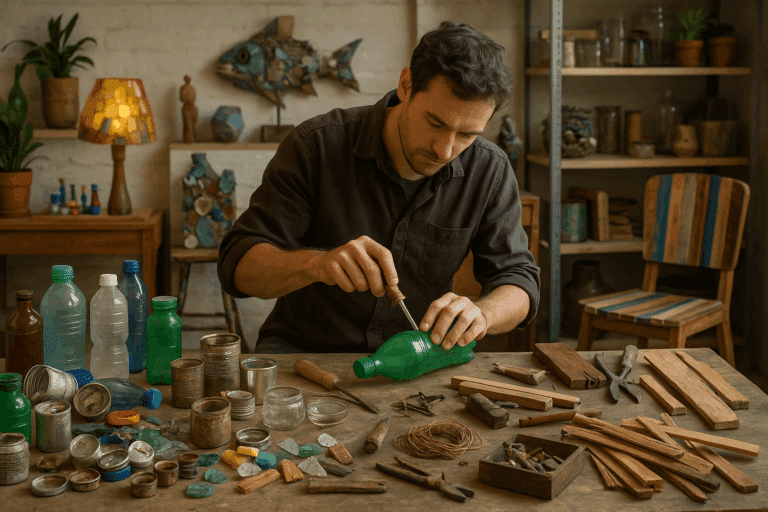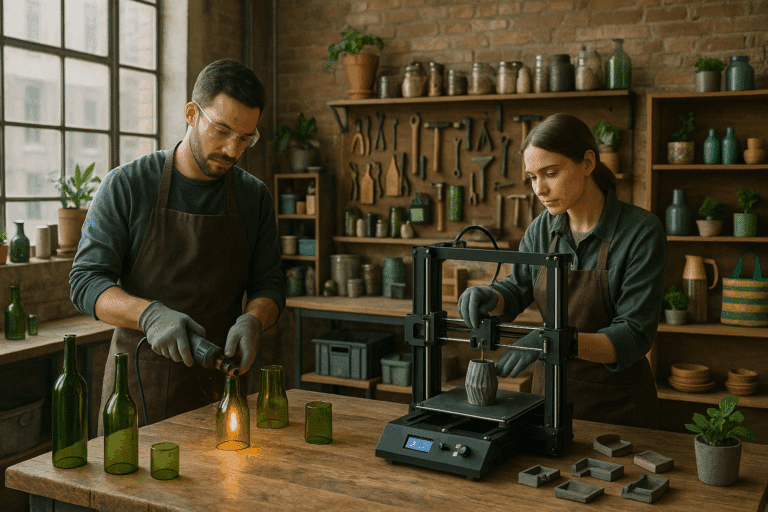This innovative concept of recycling CD cases into a compact greenhouse is not only environmentally friendly, but also a trendy solution for gardening in small spaces. In the upcoming sections, we delve into the step-by-step process of constructing your own CD case greenhouse, helping you grow your garden in style, even in the limited confines of an urban setting.

The gardening world is experiencing a paradigm shift towards sustainable and compact solutions, with the CD case greenhouse emerging as a frontrunner. This greenhouse is an epitome of style and sustainability, making gardening accessible for everyone, especially those residing in the city with constrained outdoor spaces. As we navigate through the process of creating this greenhouse, you’ll realize how simple and cost-effective it is to own a miniature garden that thrives throughout the year.
Through this innovative approach, we aim to promote the idea of ‘green living’ and inspire urban dwellers to adopt environmentally friendly practices. By recycling and reusing CD cases, we are reducing landfill waste, and by creating a space for urban gardening, we are contributing to a greener planet. So, join us as we embark on this exciting journey of creating a sustainable, stylish, and space-efficient solution for urban gardening – the CD case greenhouse. 🌱🏡🌍
Understanding the Concept of a CD Case Greenhouse
The CD case greenhouse is an innovative, sustainable solution to urban gardening. These compact structures, built from repurposed CD cases, offer an efficient method of growing your own produce in restricted spaces. In urban areas, where open land is often scarce, this method can be particularly beneficial.
The unique design of a CD case greenhouse allows for excellent light penetration, making it an optimal environment for plant growth. Its compact design, typically measuring around 12″ x 12″ x 12″, means that it can easily be placed on a balcony, patio, or even inside an apartment near a window, without occupying much space.
CD Case Greenhouse
A CD case greenhouse offers numerous advantages. Firstly, it allows urban dwellers to engage in gardening, an activity often associated with peace and relaxation. The process of growing your own food can be incredibly satisfying, contributing to your mental wellbeing. The visual and tactile stimulation of working with plants helps reduce stress, encourages mindfulness, and can even improve mood and focus. For people living in apartments or areas with limited outdoor space, this miniature greenhouse provides a compact, accessible way to reconnect with nature.
Secondly, the use of CD cases provides a solution to the growing problem of electronic waste. CD cases are made from polystyrene, a type of plastic which takes hundreds of years to decompose in landfill. By repurposing these cases into greenhouses, we can help to reduce waste and conserve our environment. It’s a small but meaningful step toward a circular economy, turning obsolete items into practical, eco-friendly tools that serve a new purpose. This approach promotes sustainability and encourages creativity in finding alternative uses for discarded materials.
Finally, plants grown in a CD case greenhouse are less likely to be affected by pests and diseases, as the enclosed environment provides a level of protection. This could lead to healthier, higher-yielding crops. Additionally, the controlled microclimate inside the greenhouse supports early germination, enhances moisture retention, and provides consistent warmth—factors that are essential for optimal plant development. It’s an ideal environment for starting seeds, experimenting with cuttings, or cultivating delicate herbs and greens year-round.
Benefits of a CD Case Greenhouse
Building a CD case greenhouse is not only a resourceful way to recycle old materials but also a fun and creative DIY project. With a little planning and patience, you can create a functional miniature greenhouse that is perfect for growing herbs, seedlings, or small leafy greens.
Step-by-Step Guide (Detailed)
1. Gather Your Materials:
You will need approximately 40 to 50 clear CD jewel cases. Try to use ones that are in good condition—cracks or heavy scuffing may reduce light transmission and compromise structural stability. You will also need strong, clear adhesive tape (or a hot glue gun for stronger bonds), scissors or a craft knife, and optional extras like hinges, Velcro, or magnets for the door.
2. Prepare the CD Cases:
Remove the plastic inserts and paper covers from all CD cases. Give them a thorough cleaning using a soft cloth and a mix of water and mild dish soap. This ensures maximum light transmission, which is essential for plant growth.
3. Constructing the Walls:
Begin by laying out a row of CD cases, side by side, and taping their edges together. Then build up by stacking and taping more rows on top until you reach the desired height. Repeat this process for each wall panel—typically four panels (front, back, and two sides). Reinforce the corners with extra tape or glue to maintain structural integrity.
4. Assembling the Roof:
For a basic roof, connect CD cases in a triangle or pyramid shape. This design not only improves aesthetic appeal but also helps rainwater run off naturally if you choose to use your greenhouse outdoors. Ensure the roof is securely attached to the walls using tape or additional supports.
5. Adding a Door:
For accessibility, design one side of the greenhouse with a hinged or removable door made from two to four CD cases. Use duct tape or small cabinet hinges to allow it to swing open. Velcro strips or magnets can help keep the door closed.
Maintaining Your CD Case Greenhouse (Expanded)
Once built, your CD case greenhouse will require ongoing care to remain effective and attractive.

Cleaning:
Dust, dirt, or water stains can quickly accumulate on the surfaces, reducing light penetration. Wipe the CD surfaces with a damp cloth every couple of weeks and use a vinegar-water solution for tougher stains.
Sealing Gaps:
Check periodically for gaps or weakened adhesive. Small openings can let in pests or cause heat to escape. Use tape or silicone sealant to patch and reinforce problem areas.
Air Circulation:
Because CD case greenhouses are small, they can overheat or become too humid. Leave the door open slightly during the hottest part of the day or install a small vent to allow air circulation.
Structural Checks:
Weather and age can impact the plastic over time. Inspect your greenhouse monthly to ensure no parts are warping or coming loose, and replace any damaged cases promptly.
With these thoughtful additions and maintenance tips, your CD case greenhouse will remain a functional and charming mini garden all year round.
Building Your CD Case Greenhouse
Building a CD case greenhouse is a relatively simple process. You will need around 40-50 CD cases, some clear adhesive tape, and a pair of scissors.
Step-by-Step Guide
- Start by removing any paper inserts from the CD cases and cleaning them thoroughly. This will ensure maximum light penetration.
- Next, you will need to construct the sides of the greenhouse. This involves sticking the CD cases together using the adhesive tape. Aim to create a square structure.
- The roof of the greenhouse can be made by sticking CD cases together in a pyramid shape. This will allow rainwater to run off the sides.
- Finally, the door of the greenhouse can be created by attaching a couple of CD cases together and taping them to one side of the structure.
Maintaining Your CD Case Greenhouse
Once your CD case greenhouse is constructed, you’ll need to consider the best ways to maintain it. This includes regular cleaning to ensure maximum light penetration, as well as monitoring the temperature and humidity levels.
Cleaning
Cleaning your CD case greenhouse is crucial in ensuring your plants receive the maximum amount of light. Over time, dust and dirt can accumulate on the CD cases, which can limit light penetration. Using a soft cloth and some mild detergent, give the cases a gentle clean every few weeks. Be sure to rinse off any soap residue, as leftover detergent can leave a film that reduces transparency. Additionally, regularly check for mold or algae growth inside the greenhouse, particularly around moist areas like the base or corners of the structure. These growths can thrive in humid conditions and may harm delicate seedlings or young plants. A solution of vinegar and water can be used as a natural disinfectant to remove any organic buildup without introducing harmful chemicals.
Temperature and Humidity
Keeping an eye on the temperature and humidity levels within your CD case greenhouse is essential. Most vegetables and fruits prefer a temperature between 55°F and 75°F. Humidity should be kept between 50% and 70%. A small, indoor thermometer and hygrometer can be used to monitor these conditions. In colder months, consider placing the greenhouse near a south-facing window to maximize natural warmth, or use a small heating mat under the structure to maintain a steady root temperature. During warmer periods, open a panel or prop the lid slightly to allow for ventilation and prevent overheating. Stagnant air can lead to mold growth and rot, so proper airflow is vital even in a miniature environment.
Choosing Plants for Your CD Case Greenhouse
Choosing the right plants for your CD case greenhouse is a crucial step. Due to the compact size of these greenhouses, it’s best to opt for smaller plants or seedlings. Consider also the plant’s light requirements and growth speed, especially if you want to enjoy a quick harvest or rotate crops seasonally.
Best Plants to Grow
Some of the best plants to grow in a CD case greenhouse include lettuce, spinach, and other leafy greens. These plants do not require a lot of space to grow and are perfect for a small greenhouse. Herbs like basil, parsley, and dill are also great options. You may even experiment with microgreens, which grow quickly and can be harvested in just 1–2 weeks. For a touch of color, try growing edible flowers such as nasturtiums or calendula—they’ll add both visual interest and flavor to your dishes.
Best Plants to Grow
Some of the best plants to grow in a CD case greenhouse include lettuce, spinach, and other leafy greens. These plants do not require a lot of space to grow and are perfect for a small greenhouse. Herbs like basil, parsley, and dill are also great options. You can also try chives, oregano, or thyme, which thrive in compact environments and offer culinary value. For variety, consider growing microgreens—nutrient-dense shoots of vegetables like arugula or radish that mature quickly and can be harvested in just a couple of weeks. Their fast growth makes them ideal for the small, controlled environment of a CD case greenhouse.
Conclusion
The CD case greenhouse is a sustainable, innovative solution for urban gardening. Not only does it allow you to grow your own produce in a small space, but it also helps to reduce electronic waste. With some simple maintenance and the right choice of plants, you can enjoy fresh, homegrown produce all year round.
In conclusion, the CD Case Greenhouse concept provides an innovative, sustainable solution to urban gardening. It’s not only a stylish, space-saving way to grow your own garden but also a great opportunity to reuse old CD cases. By repurposing these cases, we can reduce waste and contribute to a healthier environment, proving that sustainability and style can indeed go hand in hand.
Moreover, this concept allows urban dwellers to engage with nature, grow their own produce, and enjoy the therapeutic benefits of gardening, despite space constraints. The compact and portable nature of the CD Case Greenhouse makes it an ideal fit for balconies, windowsills, and other small urban spaces.
Therefore, whether you’re an experienced gardener looking for a new project, a city dweller craving a touch of greenery, or an environmentally-conscious consumer searching for sustainable solutions, the CD Case Greenhouse could be the perfect fit. So why not give it a try and grow your garden in style while supporting sustainability? 🌿🌱🍅
Remember, every small step towards sustainability counts, and your green thumb can truly make a difference.



